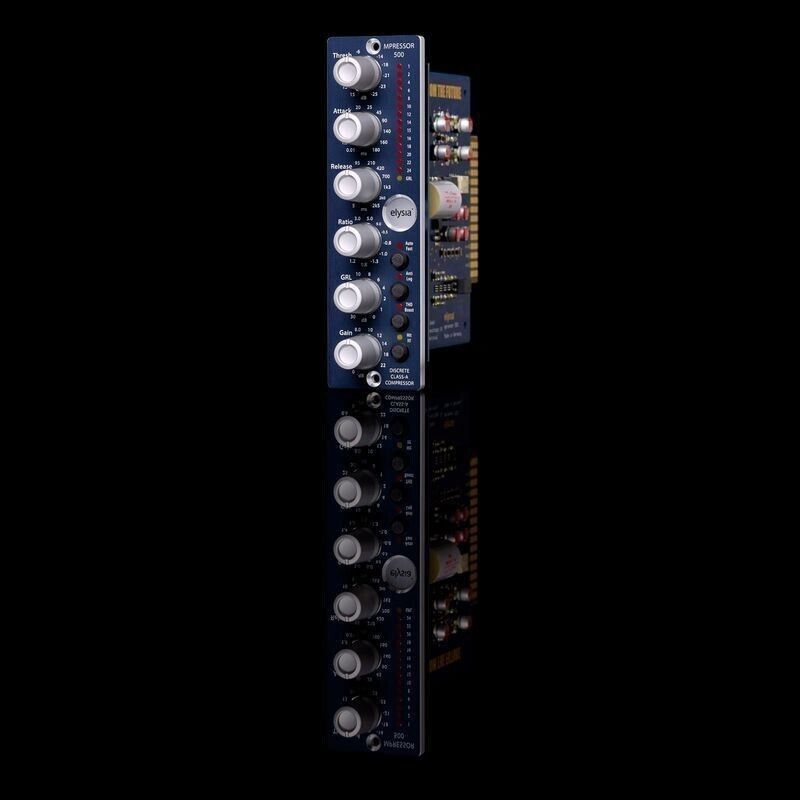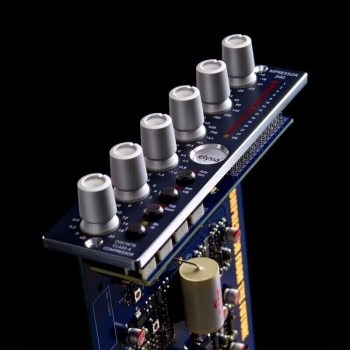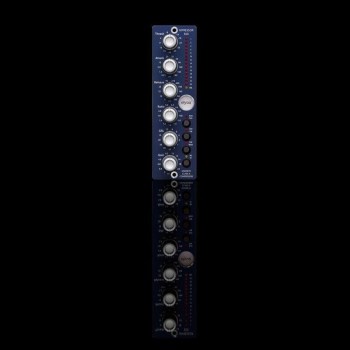mpressor 500
Creative Analog Compressor Module
Control Freak
Extreme time constants, negative ratios, antilog release and elysia’s innovative gain reduction limiter provide a whole spectrum of unique dynamics shaping options. A new feature of the 500 series module is its switchable THD boost allowing on-the-fly signal coloration and saturation effects capable of delivering a grittier flavor.
THD Boost
Activating the THD Boost function raises the level in front of the gain control element. This generates additional harmonics inside the input stage of this amplifier, which has a significant influence on the sonic structure of a signal.
The mpressor 500 is a pure feed forward compressor, and the gain potentiometer is placed before the control element. This means that the intensity of the saturation can be raised or lowered by different settings of the gain controller.
What’s special: The detector in the sidechain of the compressor runs in parallel and is therefore not influenced by the THD Boost at all. The actual compression does not change, it is only the sound which is being influenced.
You generate a saturated signal which as a result is also reduced in dynamics, but the actual control of the compressor itself is always based on the original dynamics including all transients, impulses and so on.
Auto Fast
The attack parameter is a very crucial factor for the operations of a compressor. Choosing the right time settings is very important, but depending on the dynamic progress of the source material this can be a difficult task – no matter if single tracks or complete mixes are processed.
If a very short attack time is chosen, the compressor is able to catch the short peaks, but on the other hand the sustaining signal will also be processed, which might result in audible distortion. Longer settings reduce distortion significantly, but then the compressor is too slow for catching fast impulses.
This is where the Auto Fast function comes into play. For example, if you set the attack to 80 ms and then engage the Auto Fast mode, the attack time will be shortened automatically on fast and loud signal impulses. The compressor reduces the signal quickly and prevents it from slipping through.
Then the attack time directly and automatically returns to its original setting. In Auto Fast mode the compressor can be very fast, but only when it is really needed. This function influences the attack parameter on short and loud impulses only; in all other cases the original setting of the controller has priority.
Gain Reduction Limiter
A specialty of the mpressor 500 is the Gain Reduction Limiter for the control voltage. This limiter is not placed in the audio path where you would usually find it, but in the control path of the compressor. When it is activated, it limits the control voltage according to the setting of the GR Limit controller. This means: No matter how high the input level might become – the amount of gain reduction will never exceed the value which you have set.
For comparison, imagine a fader on a mixing console with your hand moving the fader to ‘play compressor’. If now the fader was limited by a piece of duct tape at -10 dB, for example, it could only reduce the signal up to this value. If the input level dropped below this limit, the fader would be moved up correspondingly.
However, if the input signal got even louder, the fader could not be moved down any further because of the duct tape limit, and then the output signal would become louder again in correspondence with the input signal.
Loud parts in an arrangement can keep their dynamics, as they will not be compressed beyond the limit of the Gain Reduction Limiter. Some very nice special effects like ducking or upward compression can be achieved with this easily by only reducing the quieter parts without changing the original dynamics at the same time.
Analog Dynamic LED Meter
The gain reduction meter is a very important visual tool for evaluating the operation of the compressor in addition to what your ears tell you. A lot of devices make use of sometimes more, sometimes less precise VU meters. But because of the inertia of the needle these meters are only useful with moderate time parameters.
Another popular form of meter is the LED chain. Unfortunately it has a disadvantage, too: When the standard driver units are used, the change between two values always happens abruptly. A single LED in the chain can therefore only show an imprecise value in a defined interval. Hectic flicker indicates that the actual value must be somewhere in between.
The mpressor 500 solves these problems by using an analog dynamic variant that combines the benefits of both VU meters and LED chains. This meter is based on LEDs, too, but a special circuit design makes it possible to show intermediate values by modulating the brightness of the LEDs.
This means a true analog way of showing the operation of the compressor: Very fast, but with smooth transitions. The user gets an important tool for precise gain reduction monitoring – finally the relationship between acoustic and visual perception feels just right.
Technical Data
Frequency response
THD+N
@ 0dBu, 20Hz – 22kHz: 0.04%
@ 10dBu, 20Hz – 22kHz: 0.19%
@ 0dBu, 20Hz – 22kHz, THD Boost: 0.24%
@ 10dBu, 20Hz – 22kHz, THD Boost: 2.20%
Noise floor
20 Hz – 20 kHz (A-weighted): -79dBu
20Hz – 20kHz (A-weighted), THD Boost: -87dBu
Dynamic range
20 Hz – 22 kHz: 99 dB
Maximum level
Input: 21 dBu
Output: 22 dBu
Impedance
Input: 10 kOhm
Output: 68 Ohm
Power Consumption
Total: 75 mA
 Купить Elysia mpressor 500 - лучшая цена с доставкой по России в mustore.ru
Купить Elysia mpressor 500 - лучшая цена с доставкой по России в mustore.ru  Купить Elysia mpressor 500 - лучшая цена с доставкой по России в mustore.ru
Купить Elysia mpressor 500 - лучшая цена с доставкой по России в mustore.ru  Купить Elysia mpressor 500 - лучшая цена с доставкой по России в mustore.ru
Купить Elysia mpressor 500 - лучшая цена с доставкой по России в mustore.ru  Купить Elysia mpressor 500 - лучшая цена с доставкой по России в mustore.ru
Купить Elysia mpressor 500 - лучшая цена с доставкой по России в mustore.ru 


















